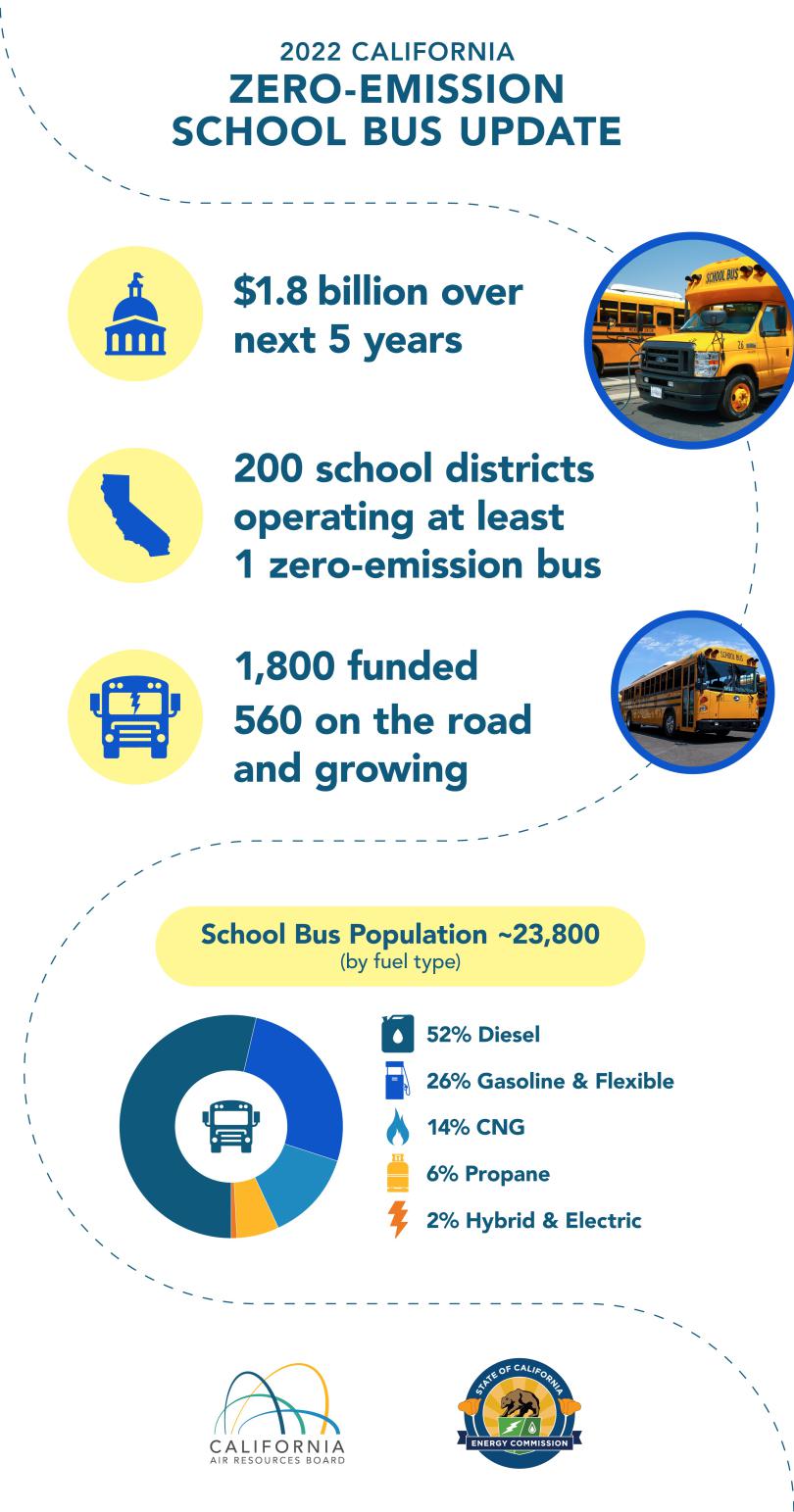For Immediate Release: October 12, 2022
State’s investments surpass $1.2 billion with more than 1,800 zero-emission school buses operating or on order
SACRAMENTO — A report published today by the California Air Resources Board, in consultation with the California Energy Commission, demonstrates the state’s nation-leading progress in cleaning up its school bus fleet. The 2022 SB 1403 School Bus Incentive Program Report shows California is charging ahead with zero-emission school buses and outlines a path for the latest nearly $2 billion investment.
Cleaning up the state’s school bus fleet improves air quality for students and surrounding communities. To date, investments to clean up old, polluting school buses exceed $1.2 billion. And the Legislature has appropriated an additional $1.8 billion over the next five years for zero-emission school buses and associated charging infrastructure.
The total $1.2 billion statewide investment made over the past nearly 20 years, including $255 million invested in school bus cleanup over the past year alone, has supported about 1,800 zero-emission school buses. More than 560 of those buses are already on California roadways and 327 are in the state’s most pollution-burdened communities. California leads the nation with its strong support for zero-emission school buses. By comparison, 888 zero-emission school buses have been awarded, ordered, or deployed across the U.S. outside of California, as of 2021, according to a CALSTART report.
Electric school buses now make up 2% of California’s fleet of 23,800 school buses. More than half of the state’s school bus fleet is diesel powered, and a handful of the state’s buses even pre-date engine emission controls altogether. Transitioning to zero-emission technologies not only will help California meet its clean air and climate goals, but clean buses protect children who are particularly vulnerable to the health impacts of diesel exhaust, even from newer engines.
“Older diesel school buses expose children to toxic emissions so it’s essential that we move to cleaner technologies, particularly since children are among the most vulnerable to air pollution impacts,” CARB Chair Liane Randolph said. “And helping school bus fleets transition to zero-emission vehicles has the added benefit of supporting our climate change and petroleum reduction goals.”
“While helping California meet its clean air and carbon neutrality goals, zero-emission school buses also help us address the climate crisis by advancing zero-emission vehicle adoption and grid resiliency through vehicle-to-grid technology,” California Energy Commissioner Patty Monahan said.
Cleaning up the school bus fleet is a collective local, state and federal effort since there is no single dedicated source of funding for school bus replacement. A variety of CARB incentive programs over the past 20 years have focused on cleaning up school buses, including several recent funding allocations to replace aging school buses with new zero-emission models. Together, CARB and CEC are funding new projects that get old, dirty buses off California roads and invest in zero-emission technologies and infrastructure. It’s these new, clean technologies that will help California meet its ambitious clean air and climate goals that ultimately help school kids — and all of us — breathe easier.
In addition to state funding, late last month, the U.S. Environmental Protection Agency announced it would nearly double the funding awarded through its Clean School Bus Program this year to $965 million following increased demand, with school districts from all 50 states applying for 2022 Clean School Bus Rebates. The rebates are part of President Biden’s Bipartisan Infrastructure Law which created an historic $5 billion investment for low- and zero-emission school buses over the next five years.
Old, polluting, diesel school buses are harmful to children’s health, as they expose children and communities to toxic tailpipe-related air pollution. Airborne particles from diesel exhaust have the potential to cause cancer, premature death and other health problems.
Electric school buses also support grid reliability. More than 500 state-funded school buses include vehicle-to-grid technology capable of using the batteries on board the buses to soak up energy and recharge during downtime when clean energy is abundant on the grid and return energy to the grid in the afternoon and evening.
The potential of this resource was recently demonstrated during the extreme heat event in September when the Cajon Valley Union School District used its electric school buses funded by federal and state grant programs as a virtual power plant and discharged electricity back to the grid.
To help visualize the information in the SB 1403 progress report, CARB and CEC host online tools — the CARB-Funded Zero Emission School Bus Dashboard and the CEC School Bus Delivery Tracker — that track and map the growing number of state-funded ultra-clean school buses on California roads.
More search functions added to CARB’s interactive dashboard
CARB’s recently updated zero-emission school bus dashboard now features several ways to search for zero-emission school bus deliveries and orders across the state. Find out how many are in your community, your air district or your congressional district. Or see how many clean buses are in communities with the greatest economic and environmental impacts in California.
CARB’s dashboard data is updated twice per year, with information compiled from various CARB-funded and -implemented school bus funding sources. Many of these funding programs are part of California Climate Investments, a statewide initiative that puts billions of cap-and-trade dollars to work reducing greenhouse gas emissions, strengthening the economy, and improving public health and the environment — particularly in communities with greater economic and environmental burdens.
The SB 1403 report is published as part of CARB's “Proposed Fiscal Year 2022-23 Funding Plan for Clean Transportation Incentives.” The public is invited to submit comments to the Funding Plan through Nov. 14.
About the California Air Resources Board
CARB's mission is to promote and protect public health, welfare, and ecological resources through effective reduction of air pollutants while recognizing and considering effects on the economy. CARB is the lead agency for climate change programs and oversees all air pollution control efforts in California to attain and maintain health-based air quality standards.

